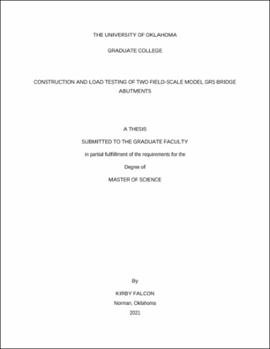| dc.description.abstract | Geosynthetic Reinforced Soil-Integrated Bridge System (GRS-IBS) is an alternative bridge construction technique to conventional, deep-foundation bridge abutments. GRS-IBS has shown signs of expedited construction speeds and can be constructed with locally sourced materials, leading to a cost-effective solution. Most suitable for small county roads, the integrated approach may reduce the magnitude of the “bump-at-the-end-of-the-road” by eliminating differential settlement between the superstructure and existing roadway. Factors effecting the performance of these bridge systems have been previously studied through field-scale models located at The University of Oklahoma. As an extension of those studies, this paper aims to further explore various combinations of factors and their effects on the structural performance of GRS-IBS. The findings of this research will be compared with those from previous studies.
Two models were constructed, tested and compared to previously tested models. Constructed with large facing blocks, dense-graded aggregate and three compaction passes, GRS Abutment Model #7 was anticipated to produce the stiffest response of all models. Though still in accordance with FHWA guidelines, the model did not produce the anticipated stiffness as it responded similarly to other models constructed with large facing blocks, regardless of the backfill type, compaction effort, and spacing of reinforcement. The second model, GRS Abutment Model #8, aimed to produce results that most realistically reflected the performance of in-service GRS-IBS structures by implementing a beam seat width that satisfies the FHWA guidelines. Results show that the increased beam seat width (24 vs 8 inches) permitted larger loads for similar settlement magnitudes. The facing deformations and reinforcement strains increased largely relative to previously tested GRS abutment models, though this is likely closely associated with the decreased setback distance. | en_US |
